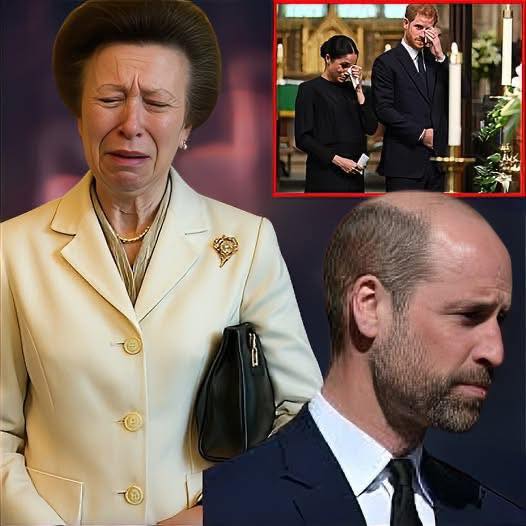A day that had started quietly across the United Kingdom was abruptly pierced by a deeply emotional and unexpected announcement from Princess Eleanor of Westmarch, sending ripples of shock through both the monarchy and the public. Standing in Windsor’s East Hall, she faced the cameras, her voice calm yet her eyes reflecting profound sorrow, as she delivered news that no one had anticipated.
“It is with the heaviest of hearts that I announce the peaceful passing of Lady Amelia Rothesay, my dear cousin and one of the most gentle and luminous souls in our family. Her life was devoted to kindness, culture, and service. We are heartbroken,” Eleanor said, her words hanging in the still air.
Lady Amelia, 61, the only daughter of the late Princess Helena—Queen Margaret II’s younger sister—had lived largely outside the public eye, choosing privacy over attention. Known for her quiet strength, artistic talent, and steadfast devotion to family, she remained a figure of grace even amid turbulent times.
A gifted painter and committed patron of the Royal School of Illustration, Lady Amelia’s work was celebrated far more for its artistry than her royal connections. Her exhibitions, often intimate and understated, drew admirers worldwide, who marveled at the way she captured emotion with a reverence that felt almost sacred.
The palace confirmed that Lady Amelia passed away early this morning, following a brief but serious illness that had been kept private. She died in her London townhouse, surrounded by her husband, her sons, and two close friends who had remained at her side.
The announcement stunned both royal-watchers and members of the family. Amelia had never courted controversy. She held no political ambitions. She was simply cherished—quietly, profoundly, and consistently.
The shock deepened when news came shortly afterward that Prince Adrian and Duchess Maren of Redwood, long residing abroad, were returning to the United Kingdom immediately. Though they had stepped away from royal duties three years prior and settled in the United States, Adrian and Maren had maintained a close, affectionate bond with Lady Amelia.
Palace insiders noted that Adrian had always regarded Amelia as one of the few relatives who saw him not as a symbol or a scandalized heir, but as a person. Privately, he described her as “the rare royal who balances duty with heart.”
Friends and aides recalled that Amelia never judged Adrian for leaving royal life behind. She wrote him handwritten letters—thoughtful, lengthy missives—offering encouragement when the press criticized him. Compassion and honesty defined her relationships, and Adrian was reportedly among the few to whom she fully confided her feelings about royal pressures. It was therefore unsurprising that the couple booked the next available flight as soon as they learned of her passing.
The monarchy itself felt the loss acutely. King Rowan III, who had played with Amelia in the gardens of Summerwood House during childhood, is reportedly “devastated beyond words.” Sources say he was informed late last night and has canceled his engagements this week to grieve privately.
Princess Eleanor, who shared the news, had a particularly close bond with Amelia. Childhood photographs show the cousins hand-in-hand, attending school together, and laughing at family gatherings far from prying eyes. Eleanor once described Amelia as “my anchor,” a phrase that now resonates with poignant literalness.
The royal household has entered a period of official mourning. Flags have been lowered, public appearances postponed, and the normally bustling palace grounds have fallen into an unusual quiet.
Yet beyond the ceremonial adjustments, deeper, more intimate grief is unfolding. Longtime staff and elderly retainers have been seen openly weeping. Colleagues from the Royal School of Illustration remember her as “the kindest presence in a demanding environment.” Former students and protégés have gathered outside the palace, sketchbooks pressed to their chests in silent homage.
Public reaction has been equally profound. Social media was instantly flooded with tributes, sketches, and recollections. Admirers recall her appearing unannounced at local exhibitions or community events—always approachable, always genuine, and without security. Even the monarchy’s critics seemed united in recognizing her as the embodiment of the best virtues of royalty, lived quietly.
As Prince Adrian and Duchess Maren’s plane crossed the Atlantic, speculation swirled about whether Amelia’s death could catalyze a reconciliation within the estranged family. Some commentators suggested her passing might finally bridge years of tension, while others warned that old wounds run too deep. The truth, perhaps, remains uncertain—even for Adrian and Maren themselves.
What is clear, however, is that grief has a way of surfacing buried truths. Palace aides reported that Amelia’s final days were filled with requests for personal letters and messages to family members, emphasizing private peace over public appearances.
“She sought peace,” said one aide. “Not for the institution, but for those she loved.”
Her funeral is expected next week at St. Brigid’s Chapel, a small, ivy-covered church beloved by Amelia for its quiet charm. The king will attend. Princess Eleanor will deliver the eulogy. Prince Adrian, despite the years apart, is expected to sit in the front row.
The royal family has endured scandals, divorces, abdications, and political upheaval—but grief strips away ceremony, leaving only the raw human experience. Lady Amelia Rothesay lived quietly, loved deeply, and departed without spectacle. Yet her absence has drawn the fractured branches of her family into a moment of collective mourning.
For the public, headlines will fade. Ceremonial mourning will conclude. But for those who truly knew her—cousins who leaned on her, artists she guided, and the prince she comforted across an ocean—her absence creates a void that cannot be replaced.
And perhaps, in the silent weight of her passing, long-standing fractures may finally begin to heal.
